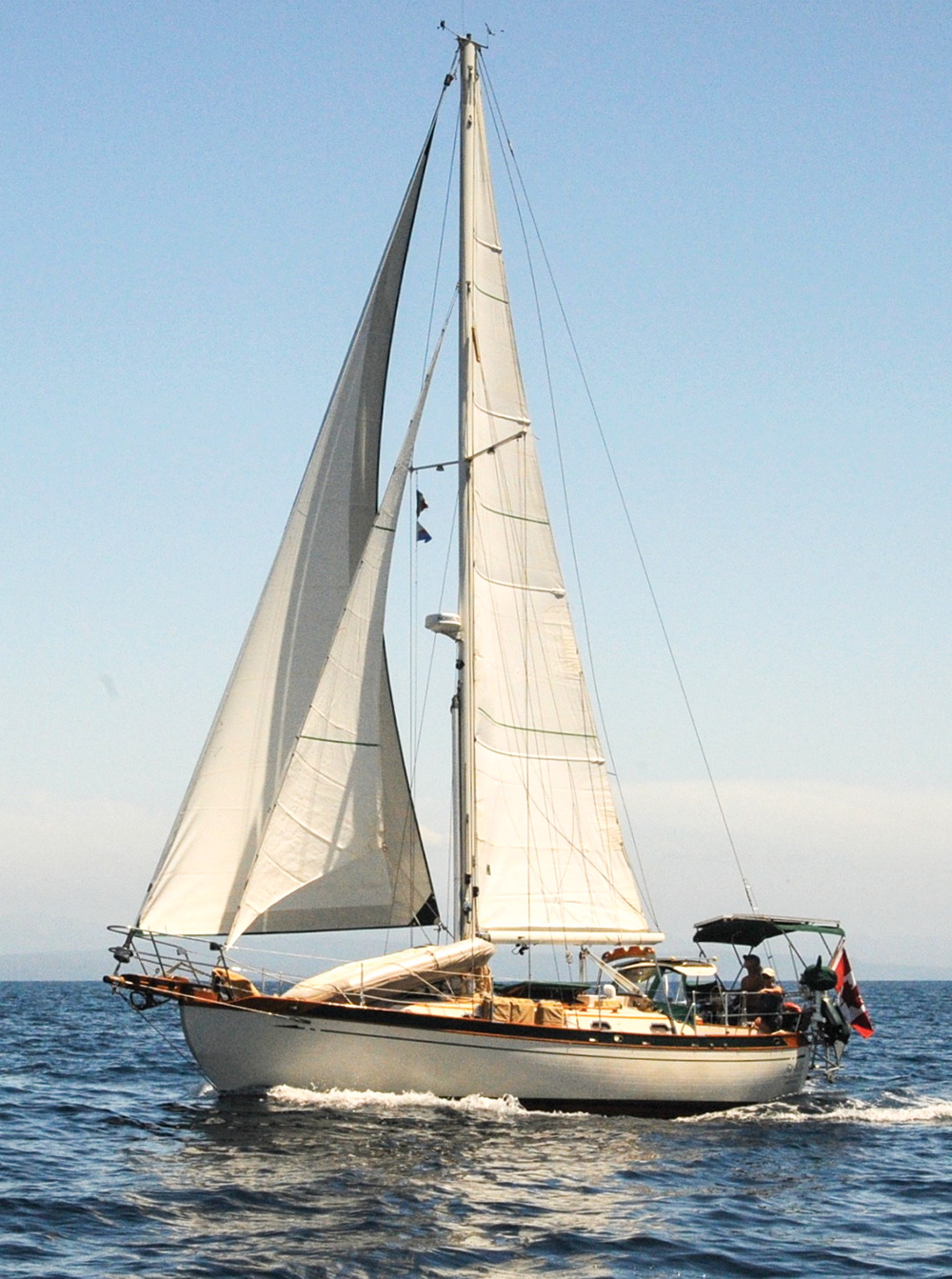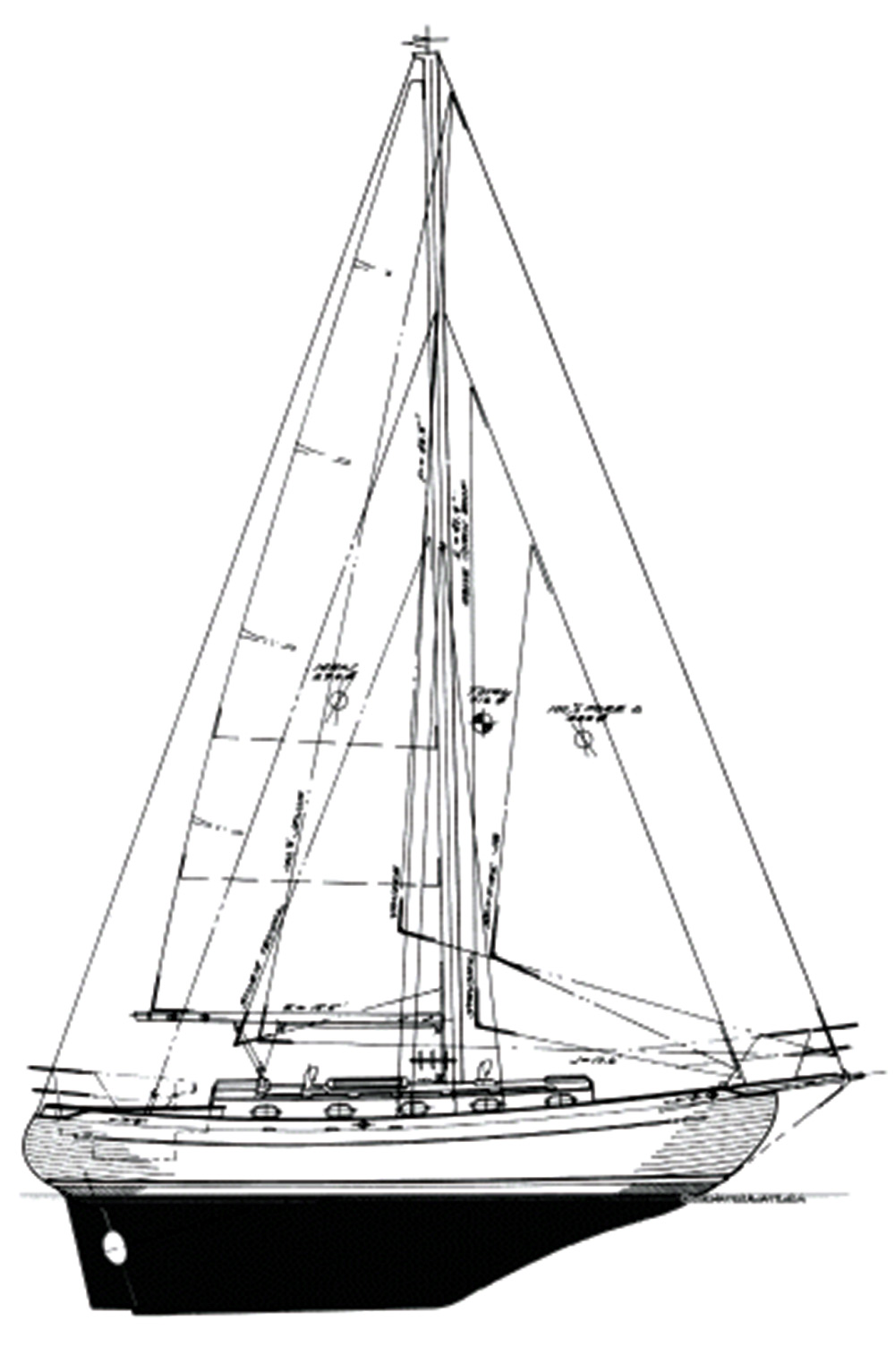Baba 35
A beautiful and rugged offshore cruiser that is perfect for a small family or a couple

Sailors who admire the Baba 35 are quick to point out that the bluewater cruiser possesses both beauty and brawn. The full-keel, double-ended cutter was designed by naval architect Robert H. Perry. When it first splashed in 1979, the boat was dubbed the Flying Dutchman.
Three years earlier, Perry’s smaller version, the Baba 30, was launched and had acquired a strong following. But not every sailor was enamored with the Baba 30’s looks or overall sailing capabilities. The main complaint was that many of her amenities appeared crowded, the proverbial 10 pounds of peanuts in a five-pound bag. While the Baba 35 was certainly more elegant and perhaps the better sailing vessel, her coming-out party was short-lived, overshadowed in 1980 by the introduction of the Baba 40.
During the 1970s and 1980s, a small group of Taiwanese boatyards gained a reputation for masterful craftsmanship and solid construction. Among these was the Ta Shing Boatbuilding Co. in Tainan, Taiwan, where the Baba yachts were built. The small yard had attracted the attention of developer Bob Berg who, at that time, was a partner in the Flying Dutchman dealership on the West Coast. Once it became evident that sailors liked Perry’s 30-footer, Berg requested the designer draft a larger version. Perry, who had already designed the Tayana 37 that had been enthusiastically received by the world sailing community, credits Berg with the boat’s efficient layout. The new design was released as the Flying Dutchman 35, but over time that name faded away and the boat became the Baba 35.
About 72 Baba 35s were built in Formosa between 1979 and 1986, compared to the 115 Baba 40s churned out by the same boatyard from 1980 to 1982.
Despite having to contend with a showy big sister only a year after her own inaugural launch, the Baba 35 offered comfortable sailing aboard a solidly built boat that turned heads as it entered the harbor. And at 35 feet, it was less expensive to purchase and maintain than her big sister.
The Baba 35s varied slightly in design, and at least seven of the 72 hulls had pilothouses. The interiors were likely to be customized with the buyer’s preferences, although all benefitted from the superb Taiwanese carpentry and functional design.
Berg has been credited with much of the efficient interior layout, ensuring the boat had plenty of storage space and the most usable configuration of dining and sleeping quarters. On some of the boats, a hanging locker or cabinet was eliminated to make room for a quarter berth.
By 1983, the interior design had evolved so that the aluminum mast was shrouded in teak as it entered the saloon, blending it with the elegant surroundings. The head was relocated from port to starboard. The galley was fitted with a diagonally positioned sink near the base of the companionway that allowed for additional cabinets.
Boat broker Bruce Smith in Newburyport, Massachusetts, has represented the owners of various Baba 35s over the years.
“It’s so unique a boat that when people call they already know about it and are looking for that particular model,” he said, noting the yacht’s good looks and sailing capabilities are coupled with a strong build.
According to Smith, the planned 2018 around-the-world Golden Globe Race, in which the yachts will have no electronic navigation or communication devices to assist them, has brought attention to the Baba 35.
“A couple of guys are looking at one that I have because they’ve been invited to race,” he said. “The Baba 35 is probably the fastest of the bunch so far.”
Smith explained that watertight bulkheads would be installed in the boat before the race as part of the requirements.

First impressions
This boat can take two people around the world. That’s the first impression given off by the Baba 35, which is both beautiful and rugged. It’s impossible not to notice the heavy-duty standing rigging, bronze portals, canoe stern, elegant teak decks and the snug, gracefully wood-trimmed cockpit with its wraparound coaming. Below deck, the rich teak and masterful wood joinery can leave classic boat aficionados speechless.
Construction
The Baba 35 boasts sound construction. The boat has a fiberglass hull, deck and cabintrunk, the deck overlaid with teak. The full keel is lead-weighted. Rigging and tankage are stainless steel. Many fittings are bronze.
What to look for
Like any older boat, the Baba 35 has its issues. The teak decks may have started to leak. “Leaky teaky” is the term some owners use. The holly sole is prone to delamination. The steel fuel tanks very likely will corrode over time and require replacement. Potential buyers often find the through-hull fittings and the standing rigging, including the chainplates, have reached the end of their usefulness. Some owners have repaired or replaced the bowsprit due to rot. Hull blistering is common, which usually requires deep sanding or peeling and the application of a new barrier coat. Engine problems often depend on how well the previous owner maintained the machinery. Owners who have repowered report having to raise the original exhaust height, which means sacrificing space above the engine.
On deck
The Baba 35 cockpit is outfitted with a binnacle compass and wheel steering, and is protected by a dodger. The cutter has adequate space along the rails for crew to move to the foredeck and back. The standing rigging is dependent upon an aluminum mast and boom. The rounded cockpit is comfortable and dry. Winches and mainsheet are strategically placed for easy reach.
Anne and Dick Woodson, owners of the 1984 Baba 35 Full & By, removed the main traveler and replaced it with a double-sheeted, 5-to-1 mainsheet system.
“I’m 70 years old and I can sail the boat downwind easily without having to wake up my husband for every tack change during the night,” she said.
Down below
Once down the companionway, sailors are greeted with masterful teak woodwork and cabinetry. The overall effect is of snug comfort in salty surroundings. To starboard, there’s a navigation station with shelves and hinged chart table storage. To port, the galley features a stove and oven, double-basin stainless sink, adequate counter space and storage lockers. Refrigeration or icebox depends on the owner.
The saloon has a settee on each side with a folding table that converts to a double berth. The Baba 35 offers plenty of ventilation from a forward hatch, dorades and bronze portals that open. Headroom in the saloon is 6 feet, 4 inches.
The number of berths can vary by boat. Some configurations call for three singles and one double berth, allowing more room for a hanging locker or additional storage compartments. Other layouts provide six berths—two doubles and two singles. The head has a shower and sink. The stainless steel freshwater tank typically holds
100 gallons.
Engine
Most of the original Baba 35s were fitted out with a Perkins 4108 four-cylinder diesel engine. The diesel was rated for approximately 35 to 50 horsepower. Some of the boats were built with Universal diesels. After more than 30 years, many have been replaced with Yanmar and Volvo engines. Fuel capacity typically varies between 62 and 70 gallons.
Underway
Woodson is a firm believer in the yacht’s bluewater sailing capabilities, having cruised the West Coast from Canada to Mexico.
“She sails beautifully and is easily balanced so both the Autohelm and Monitor wind vane work well even in heavy following seas,” she said.
Woodson noted the boat sails nicely at 30 to 40 degrees off the wind and is easy to reef.
“The spinnaker is our light-air sail. In as little as 6 knots we can sail at 4 knots,” she said.
Owners tend to agree that the Baba 35 points remarkably well in all directions but best on a reach.
“She can definitely take more than the owners. The harder it blows, the better she sails,” said Jim Swallow, owner of the Baba 35 Lizard.
Conclusion
The Baba 35 is a functional, aesthetically pleasing and affordable bluewater boat capable of taking sailors around the world in comfort and style.
Baba 35
SAILING’s Value Guide
(5-sailboat rating system)
(5-sailboat rating system)
PRICE: The price of a used Baba 35 can range from about $60,000 to $125,000, depending mostly on condition since the overall production run spanned only seven years. ★★★
DESIGN QUALITY: Robert Perry designed the Baba 35 as a bluewater cruiser. The double-ender with its canoe stern has a traditional full keel. Critics have called the hull exquisitely proportioned. The Baba 35 interior is often cited as an example of quality craftsmanship and sensible design. ★★★★
CONSTRUCTION QUALITY: The Baba 35 was built by the Ta Shing Boat Building Company LTD in Tainan, Taiwan. During the 1970s and 1980s, the boatyard maintained a reputation for sound construction. Materials used throughout were of the best quality and the interior woodworking, including the joinery, remains among the most impressive in the industry. Owners have described the overall construction as “rock solid.” ★★★½
USER-FRIENDLINESS: By all accounts, the boat is fast and stable. It can be easily singlehanded with the appropriate rigging. ★★★
SAFETY: The boat’s full keel and heavy displacement makes this bluewater cruiser safer under sail. The boat has sturdy stanchions and bow and stern pulpits. ★★★
TYPICAL CONDITION: Reports of hull blistering, corroded fuel tanks and leaking teak decks are common among Baba 35 owners. However, even the most neglectful owners may find it difficult to damage the boat’s hardy construction. ★★★½
REFITTING: Replacing leaky teak decks and hull blistering can be expensive. Original parts are hard to come by. ★★½
SUPPORT: Baba owners tend to swap information online through a Yahoo group reachable by emailing baba-l@yahoogroups.org. The Baba owner’s group website is www.babaowners.org. ★★½
AVAILABILITY: Only 72 Baba 35s were built, and in early 2016, at least eight were listed for sale in the United States. Additional boats were available in the U.S. Virgin Islands and Europe. ★★★
INVESTMENT AND RESALE: The boat has maintained its value with its quality construction and steady demand by offshore sailors. ★★★½
OVERALL SVG RATING: ★★★

Comments